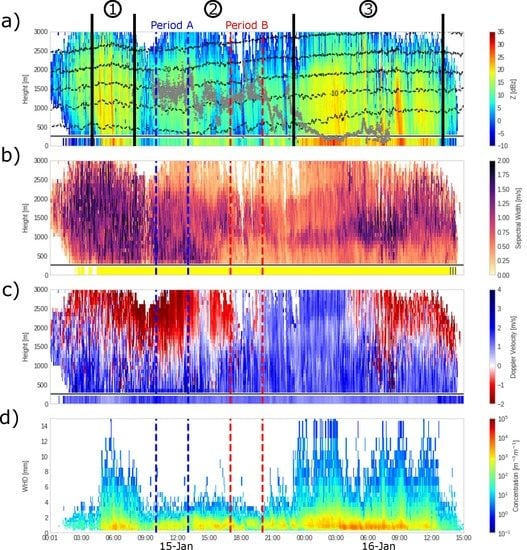Decoupling between Precipitation Processes and Mountain Wave Induced Circulations Observed with a Vertically Pointing K-Band Doppler Radar
Abstract
1. Introduction
2. Data and Methods
2.1. Rain Gauges
2.2. Micro Rain Radar
2.3. Parsivel Disdrometer
3. Results
3.1. General Description of the 15–16 January Event
3.2. Evolution of the 15–16 January Event
- Stage 1: From 5:00 to 8:00 UTC on 15 January, some snow showers with reflectivity in pockets were observed over Das. During this stage precipitation particles measured by the Parsivel disdrometer were very large as expected from aggregation inside the reflectivity pockets, similarly as in the study reported by [40].
- Stage 2: From 8:00 UTC to 23:00 UTC on 15 January, MRR and Parsivel reflectivity scaled back and precipitation resembled to be more constant and lighter. Particles arriving to the ground were mostly small (WHD < 3 mm).
- Stage 3: From 15 January 23:00 UTC to 16 January 13:00 UTC, reflectivity was again enhanced increasing the temporal variability due to new snow showers. During this stage, the largest precipitation particles of the event were observed while small particles also increased in number.
- Doppler velocity is dominated by updrafts beyond 1500 m agl over the MRR until 15:00 UTC, revealing the location of the upstream part of a mountain wave that it is consistent with the measures of the UHF wind profiler located 3 km northwest of Das. After that, updrafts steadily reduce and fall velocities dominate over the MRR location. This regime change has been identified as a mountain wave, diminishing its wavelength around 15:00 UTC and generating a rotor later [38]. The returning current of the rotor was observed by the MRR as 5 ms−1 northward flow at low levels (see Period B in Figure 4d). Falling velocities in upper MRR levels dominate until approximately 5:00 UTC on 16 January with the appearance of new updrafts that may be associated to a new mountain wave and may extend to the low levels during the largest convective cells.
- During Stage 1, large values of spectral width dominate at all height levels. When the towering reflectivity enhancement ceases, spectral width over 2000 m above ground level dramatically decreases, but high values still dominate at low levels. At 16:00 UTC, coinciding with a sudden surface temperature diminution and wind direction change (Figure 5), spectral width drops-off at low-levels, presumably due to a nocturnal cold pool formation. From this moment to 4:00 UTC, three decoupled layers are observed even when reflectivity pockets start again. After 4:00 UTC spectral width gets enhanced again at middle and upper levels, but the low-level layer remains decoupled. This behaviour is qualitatively consistent with the evolution of Turbulence Kinetic Energy derived from UHF wind-profiler data for the same period (not shown).
3.3. Impact of Local Kinematic Structures into Precipitation Patterns
3.3.1. MRR Observations
- During Period A, spectral width shows large values between 1.0 and 1.5 m s−1 at low levels, values around 1.0 m s−1 between 1000 and 2000 m agl, and values lower than 1.0 m s−1 above 2000 m agl. Vertical velocity shows a gradient from downward velocities around 2 m s−1 to upward velocities around -2 m s−1 that are the result of overlaying the vertical movements of the wind with the falling velocity of the particles with respect to the air—typical snowflakes terminal velocities are about 1 m s−1 [42] but they may fluctuate from the mean [43].
- During Period B, three decoupled layers can be distinguished: the bottom and the top layer with very low turbulence, under 0.5 m s−1, and a middle shear layer [4] with large turbulence between 0.5 and 1.0 m s−1. Fall velocities between 0 and 2 m s−1 dominate in this period at all levels. It is observed a slight increase of the fall velocity closer to the ground inside the shear layer.
3.3.2. Parsivel Observations
4. Discussion and Conclusions
Author Contributions
Funding
Acknowledgments
Conflicts of Interest
Appendix A
Appendix B
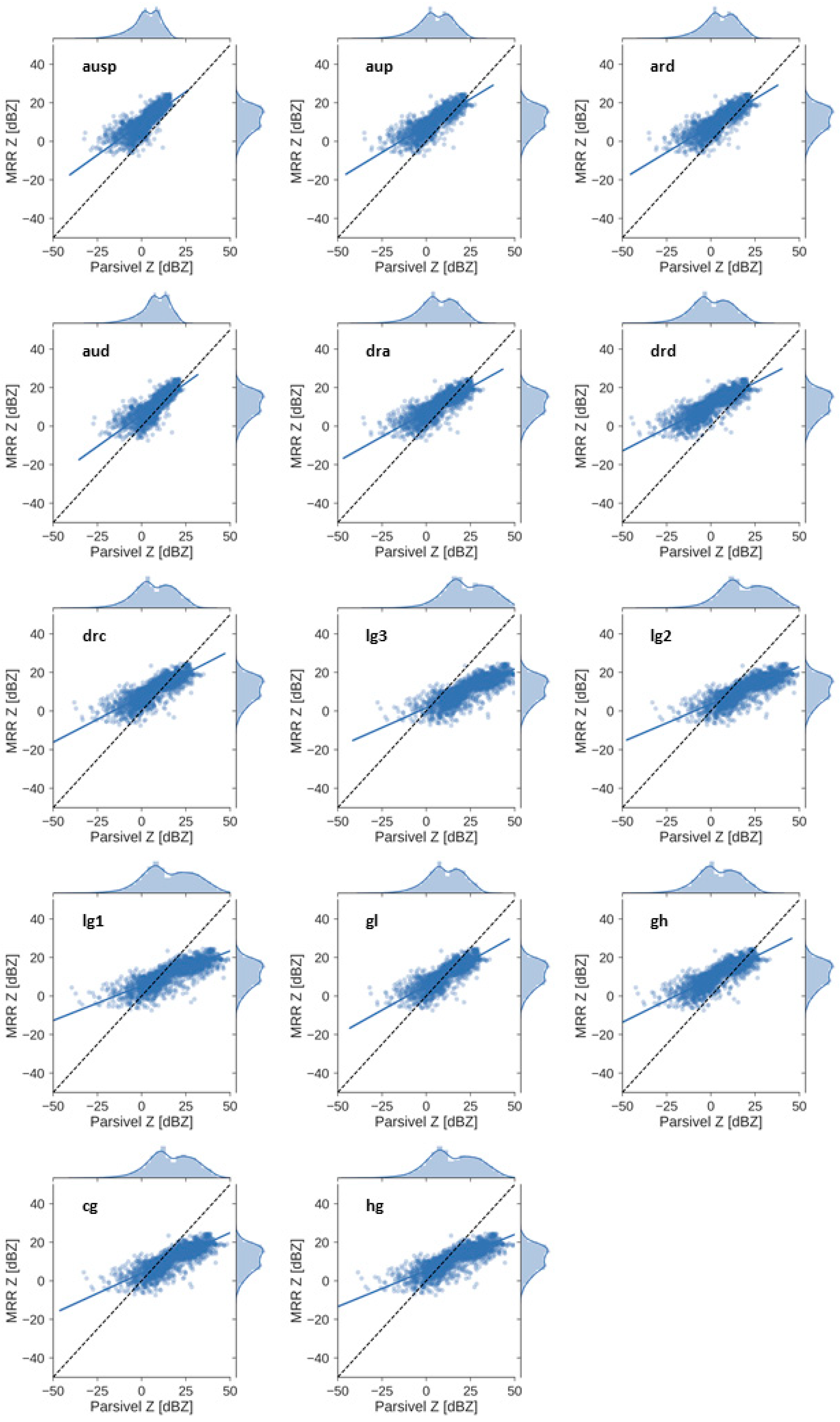
| All | 1 | 2 | 3 | |||||
|---|---|---|---|---|---|---|---|---|
| Solid Precipitation Particle Type | b | a | b | A | b | a | b | a |
| Aggregates of unrimed side planes (ausp) | 0.657 | 9.29 | 0.430 | 12.17 | 0.777 | 7.05 | 0.630 | 10.62 |
| Aggregates of unrimed assemblages of plates, side planes, bullets and columns (aup) | 0.555 | 8.14 | 0.375 | 11.08 | 0.672 | 6.33 | 0.438 | 10.49 |
| Aggregates of densely rimed assemblages of dendrites or dendrites (arp) | 0.555 | 8.14 | 0.375 | 11.08 | 0.672 | 6.33 | 0.438 | 10.49 |
| Aggregates of unrimed assemblages of dendrites or dendrites (aud) | 0.657 | 5.86 | 0.430 | 9.93 | 0.777 | 2.99 | 0.630 | 7.33 |
| Densely rimed assemblages of dendrites (dra) | 0.513 | 7.34 | 0.353 | 10.40 | 0.618 | 5.56 | 0.374 | 10.31 |
| Densely rimed dendrites (drd) | 0.473 | 10.78 | 0.331 | 12.69 | 0.562 | 9.82 | 0.321 | 13.04 |
| Densely rimed columns (drc) | 0.473 | 7.55 | 0.331 | 10.42 | 0.562 | 5.97 | 0.321 | 10.84 |
| Lump graupel 3 (lg3) | 0.403 | 1.58 | 0.291 | 5.89 | 0.457 | −0.56 | 0.245 | 7.80 |
| Lump graupel 2 (lg2) | 0.389 | 3.55 | 0.283 | 7.25 | 0.434 | 1.78 | 0.230 | 9.16 |
| Lump graupel 1 (lg1) | 0.361 | 5.34 | 0.266 | 8.45 | 0.391 | 3.93 | 0.206 | 10.46 |
| Graupel-like snow lump type (gl) | 0.513 | 5.50 | 0.353 | 9.14 | 0.618 | 3.34 | 0.374 | 8.97 |
| Graupel-like snow hexagonal type (gh) | 0.454 | 9.08 | 0.320 | 11.44 | 0.534 | 7.85 | 0.299 | 12.02 |
| Conical graupel (cg) | 0.420 | 3.96 | 0.301 | 7.68 | 0.482 | 2.03 | 0.261 | 9.06 |
| Hexagonal graupel (hg) | 0.374 | 5.33 | 0.274 | 8.50 | 0.411 | 3.85 | 0.217 | 10.34 |
References
- Houze, R.A. Orographic effects on precipitating clouds. Rev. Geophys. 2012, 50, RG1001. [Google Scholar] [CrossRef]
- Bougeault, P.; Binder, P.; Buzzi, A.; Dirks, R.; Houze, R.; Kuettner, J.; Smith, R.B.; Steinacker, R.; Volkert, H. The MAP Special Observing Period. Bull. Am. Meteorol. Soc. 2001, 82, 433–462. [Google Scholar]
- Stoelinga, M.T.; Hobbs, P.V.; Mass, C.F.; Locatelli, J.D.; Colle, B.A.; Houze, R.A.; Rangno, A.L.; Bond, N.A.; Smull, B.F.; Rasmussen, R.M.; et al. Improvement of microphysical parameterization through observational verification experiment. Bull. Am. Meteorol. Soc. 2003, 84, 1807–1826. [Google Scholar] [CrossRef]
- Medina, S.; Smull, B.F.; Houze, R.A.; Steiner, M. Cross-Barrier Flow during Orographic Precipitation Events: Results from MAP and IMPROVE. J. Atmos. Sci. 2005, 62, 3580–3598. [Google Scholar] [CrossRef][Green Version]
- Yuter, S.E.; Houze, R.A. Microphysical modes of precipitation growth determined by S-band vertically pointing radar in orographic precipitation during MAP. Q. J. R. Meteorol. Soc. 2003, 129, 455–476. [Google Scholar] [CrossRef]
- Houze, R.A.; Medina, S. Turbulence as a Mechanism for Orographic Precipitation Enhancement. J. Atmos. Sci. 2005, 62, 3599–3623. [Google Scholar]
- Garvert, M.F.; Smull, B.; Mass, C. Multiscale Mountain Waves Influencing a Major Orographic Precipitation Event. J. Atmos. Sci. 2007, 64, 711–737. [Google Scholar] [CrossRef]
- Tsai, C.-L.; Kim, K.; Liou, Y.-C.; Lee, G.; Yu, C.-K. Impacts of Topography on Airflow and Precipitation in the Pyeongchang Area Seen from Multiple-Doppler Radar Observations. Mon. Weather Rev. 2018, 146, 3401–3424. [Google Scholar]
- Kingsmill, D.E.; Persson, P.O.G.; Haimov, S.; Shupe, M.D. Mountain waves and orographic precipitation in a northern Colorado winter storm. Q. J. R. Meteorol. Soc. 2016, 142, 836–853. [Google Scholar] [CrossRef]
- Cuixart, J.; Conangla, L.; Martínez-Villagrasa, D.; Wrenger, B.; Miró, J.R.; Simó, G.; Jiménez, M.A. Evolution of the temperature profile during the life-cycle of a valley-confined cold pool in the Pyrenees. In Proceedings of the 34th International Conference on Alpine Meteorology, Reykjavík, Iceland, 18–23 June 2017; pp. 191–192. [Google Scholar]
- Paci, A.; Cuixart, J.; Bech, J.; Soler, M.R.; Miró, J.R.; Aressy, P.; Arús, J.; Barrié, J.; Bouhours, G.; Bravo, M.; et al. The Cerdanya-2017 field experiment: An overview of the campaign and a few preliminary results. In Proceedings of the 34th International Conference on Alpine Meteorology, Reykjavík, Iceland, 18–23 June 2017; pp. 169–170. [Google Scholar]
- Rasmussen, R.; Baker, B.; Kochendorfer, J.; Meyers, T.; Landolt, S.; Fischer, A.P.; Black, J.; Thériault, J.M.; Kucera, P.; Gochis, D.; et al. How well are we measuring snow: The NOAA/FAA/NCAR winter precipitation test bed. Bull. Am. Meteorol. Soc. 2012, 93, 811–829. [Google Scholar] [CrossRef]
- Kochendorfer, J.; Rasmussen, R.; Wolff, M.; Baker, B.; Hall, M.E.; Meyers, T.; Landolt, S.; Jachcik, A.; Isaksen, K.; Brækkan, R.; et al. The quantification and correction of wind-induced precipitation measurement errors. Hydrol. Earth Syst. Sci. 2017, 21, 1973–1989. [Google Scholar] [CrossRef]
- Buisán, S.T.; Earle, M.E.; Collado, J.L.; Kochendorfer, J.; Alastrué, J.; Wolff, M.; Smith, C.D.; López-Moreno, J.I. Assessment of snowfall accumulation underestimation by tipping bucket gauges in the Spanish operational network. Atmos. Meas. Tech. 2017, 10, 1079–1091. [Google Scholar] [CrossRef]
- Kochendorfer, J.; Nitu, R.; Wolff, M.; Mekis, E.; Rasmussen, R.; Baker, B.; Earle, M.E.; Reverdin, A.; Wong, K.; Smith, C.D.; et al. Analysis of single-Alter-shielded and unshielded measurements of mixed and solid precipitation from WMO-SPICE. Hydrol. Earth Syst. Sci. 2017, 21, 3525–3542. [Google Scholar] [CrossRef]
- Löffler-Mang, M.; Kunz, M.; Schmid, W. On the performance of a low-cost K-band Doppler radar for quantitative rain measurements. J. Atmos. Ocean. Technol. 1999, 16, 379–387. [Google Scholar] [CrossRef]
- Peters, G.; Fischer, B.; Andersson, T. Rain observations with a vertically looking Micro Rain Radar (MRR). Boreal Environ. Res. 2002, 7, 353–362. [Google Scholar]
- Bendix, J.; Rollenbeck, R.; Reudenbach, C. Diurnal patterns of rainfall in a tropical Andean valley of southern Ecuador as seen by a vertically pointing K-band Doppler radar. Int. J. Climatol. 2006, 26, 829–846. [Google Scholar] [CrossRef]
- Adirosi, E.; Baldini, L.; Roberto, N.; Gatlin, P.; Tokay, A. Improvement of vertical profiles of raindrop size distribution from micro rain radar using 2D video disdrometer measurements. Atmos. Res. 2016, 169, 404–415. [Google Scholar] [CrossRef]
- Kneifel, S.; Maahn, M.; Peters, G.; Simmer, C. Observation of snowfall with a low-power FM-CW K-band radar (Micro Rain Radar). Meteorol. Atmos. Phys. 2011, 113, 75–87. [Google Scholar] [CrossRef][Green Version]
- Garrett, T.J.; Yuter, S.E.; Fallgatter, C.; Shkurko, K.; Rhodes, S.R.; Endries, J.L. Orientations and aspect ratios of falling snow. Geophys. Res. Lett. 2015, 42, 4617–4622. [Google Scholar] [CrossRef]
- Stark, D.; Colle, B.A.; Yuter, S.E. Observed Microphysical Evolution for Two East Coast Winter Storms and the Associated Snow Bands. Mon. Weather Rev. 2013, 141, 2037–2057. [Google Scholar] [CrossRef]
- Minder, J.R.; Letcher, T.W.; Campbell, L.S.; Veals, P.G.; Steenburgh, W.J. The Evolution of Lake-Effect Convection during Landfall and Orographic Uplift as Observed by Profiling Radars. Mon. Weather Rev. 2015, 143, 4422–4442. [Google Scholar] [CrossRef]
- Souverijns, N.; Gossart, A.; Lhermitte, S.; Gorodetskaya, I.V.; Kneifel, S.; Maahn, M.; Bliven, F.L.; van Lipzig, N.P.M. Estimating radar reflectivity—Snowfall rate relationships and their uncertainties over Antarctica by combining disdrometer and radar observations. Atmos. Res. 2017, 196, 211–223. [Google Scholar] [CrossRef]
- Gorodetskaya, I.V.; Kneifel, S.; Maahn, M.; Thiery, W.; Schween, J.H.; Mangold, A.; Crewell, S.; Van Lipzig, N.P.M. Cloud and precipitation properties from ground-based remote-sensing instruments in East Antarctica. Cryosphere 2015, 9, 285–304. [Google Scholar] [CrossRef]
- Grazioli, J.; Madeleine, J.-B.; Gallée, H.; Forbes, R.M.; Genthon, C.; Krinner, G.; Berne, A. Katabatic winds diminish precipitation contribution to the Antarctic ice mass balance. Proc. Natl. Acad. Sci. USA 2017, 114, 201707633. [Google Scholar] [CrossRef]
- Souverijns, N.; Gossart, A.; Lhermitte, S.; Gorodetskaya, I.V.; Grazioli, J.; Berne, A.; Duran-Alarcon, C.; Boudevillain, B.; Genthon, C.; Scarchilli, C.; et al. Evaluation of the CloudSat surface snowfall product over Antarctica using ground-based precipitation radars. Cryosph. 2018, 12, 3775–3789. [Google Scholar] [CrossRef]
- Maahn, M.; Kollias, P. Improved Micro Rain Radar snow measurements using Doppler spectra post-processing. Atmos. Meas. Tech. 2012, 5, 2661–2673. [Google Scholar] [CrossRef]
- Löffler-Mang, M.; Joss, J. An optical disdrometer for measuring size and velocity of hydrometeors. J. Atmos. Ocean. Technol. 2000, 17, 130–139. [Google Scholar] [CrossRef]
- Battaglia, A.; Rustemeier, E.; Tokay, A.; Blahak, U.; Simmer, C. PARSIVEL snow observations: A critical assessment. J. Atmos. Ocean. Technol. 2010, 27, 333–344. [Google Scholar] [CrossRef]
- Löffler-Mang, M.; Blahak, U. Estimation of the Equivalent Radar Reflectivity Factor from Measured Snow Size Spectra. J. Appl. Meteorol. 2001, 40, 843–849. [Google Scholar] [CrossRef]
- Smith, P.L. Equivalent Radar Reflectivity Factors for Snow and Ice Particles. J. Clim. Appl. Meteorol. 1984, 23, 1258–1260. [Google Scholar] [CrossRef]
- Locatelli, J.D.; Hobbs, P. V Fall speeds and masses of solid precipitation particles. J. Geophys. Res. 1974, 79, 2185–2197. [Google Scholar] [CrossRef]
- Dee, D.P.; Uppala, S.M.; Simmons, A.J.; Berrisford, P.; Poli, P.; Kobayashi, S.; Andrae, U.; Balmaseda, M.A.; Balsamo, G.; Bauer, P.; et al. The ERA-Interim reanalysis: Configuration and performance of the data assimilation system. Q. J. R. Meteorol. Soc. 2011, 137, 553–597. [Google Scholar] [CrossRef]
- Trapero, L.; Bech, J.; Duffourg, F.; Esteban, P.; Lorente, J. Mesoscale numerical analysis of the historical November 1982 heavy precipitation event over Andorra (Eastern Pyrenees). Nat. Hazards Earth Syst. Sci. 2013, 13, 2969–2990. [Google Scholar] [CrossRef]
- Trapero, L.; Bech, J.; Lorente, J. Numerical modelling of heavy precipitation events over Eastern Pyrenees: Analysis of orographic effects. Atmos. Res. 2013, 123, 368–383. [Google Scholar] [CrossRef]
- Esteban, P.; Martin-Vide, J.; Mases, M. Daily atmospheric circulation catalogue for western Europe using multivariate techniques. Int. J. Climatol. 2006, 26, 1501–1515. [Google Scholar] [CrossRef]
- Udina, M.; Trapero, L.; Soler, M.R.; Bech, J.; Miró, J.; Mercader, J.; Bravo, M.; Paci, A.; Ferreres, E.; González, S.; et al. Downslope windstorms, mountain waves, orographic precipitation and associated processes analysis during 10-17 January 2017 in The Cerdanya-2017 field experiment. In Proceedings of the 34th International Conference on Alpine Meteorology, Reykjavík, Iceland, 18–23 June 2017; pp. 38–39. [Google Scholar]
- Udina, M.; Soler, M.R.; Sol, O. A Modeling Study of a Trapped Lee-Wave Event over the Pyrénées. Mon. Weather Rev. 2017, 145, 75–96. [Google Scholar] [CrossRef]
- Aikins, J.; Friedrich, K.; Geerts, B.; Pokharel, B. Role of a Cross-Barrier Jet and Turbulence on Winter Orographic Snowfall. Mon. Weather Rev. 2016, 144, 3277–3300. [Google Scholar] [CrossRef]
- Toloui, M.; Riley, S.; Hong, J.; Howard, K.; Chamorro, L.P.; Guala, M.; Tucker, J. Measurement of atmospheric boundary layer based on super-large-scale particle image velocimetry using natural snowfall. Exp. Fluids 2014, 55, 1737. [Google Scholar] [CrossRef]
- Geerts, B.; Miao, Q.; Yang, Y. Boundary Layer Turbulence and Orographic Precipitation Growth in Cold Clouds: Evidence from Profiling Airborne Radar Data. J. Atmos. Sci. 2011, 68, 2344–2365. [Google Scholar] [CrossRef]
- Mitchell, D.L.; Heymsfield, A.J. Refinements in the Treatment of Ice Particle Terminal Velocities, Highlighting Aggregates. J. Atmos. Sci. 2005, 62, 1637–1644. [Google Scholar] [CrossRef]
- Kobayashi, T. On the Variation of Ice Crystal Habit with Temperature. Phys. Snow Ice 1967, 1, 95–104. [Google Scholar]
- Rauber, R.M. Characteristics of cloud ice and precipitation during wintertime storms over the mountains of northern Colorado. J. Clim. Appl. Meteor 1987, 26, 488–524. [Google Scholar] [CrossRef]
- Garrett, T.J.; Yuter, S.E. Observed influence of riming, temperature, and turbulence on the fallspeed of solid precipitation. Geophys. Res. Lett. 2014, 41, 6515–6522. [Google Scholar] [CrossRef]
- Medina, S.; Houze, R.A. Small-Scale Precipitation Elements in Midlatitude Cyclones Crossing the California Sierra Nevada. Mon. Weather Rev. 2015, 143, 2842–2870. [Google Scholar] [CrossRef]
- Tessendorf, S.A.; French, J.R.; Friedrich, K.; Geerts, B.; Rauber, R.M.; Rasmussen, R.M.; Xue, L.; Ikeda, K.; Blestrud, D.R.; Kunkel, M.L.; et al. A transformational approach to winter orographic weather modification research: The SNOWIE Project. Bull. Am. Meteorol. Soc. 2019, 100, 71–92. [Google Scholar] [CrossRef]
- Maahn, M.; Burgard, C.; Crewell, S.; Gorodetskaya, I.V.; Kneifel, S.; Lhermitte, S.; Van Tricht, K.; Van Lipzig, N.P.M. How does the spaceborne radar blind zone affect derived surface snowfall statistics in polar regions? J. Geophys. Res. 2014, 119, 13,604–13,620. [Google Scholar] [CrossRef]
- Norin, L.; Devasthale, A.; L’Ecuyer, T.S.; Wood, N.B.; Smalley, M. Intercomparison of snowfall estimates derived from the CloudSat Cloud Profiling Radar and the ground-based weather radar network over Sweden. Atmos. Meas. Tech. 2015, 8, 5009–5021. [Google Scholar] [CrossRef]
- Kulie, M.S.; Milani, L.; Wood, N.B.; Tushaus, S.A.; Bennartz, R.; L’Ecuyer, T.S. A Shallow Cumuliform Snowfall Census Using Spaceborne Radar. J. Hydrometeorol. 2016, 17, 1261–1279. [Google Scholar] [CrossRef]
- Von Lerber, A.; Moisseev, D.; Marks, D.A.; Petersen, W.; Harri, A.M.; Chandrasekar, V. Validation of GMI snowfall observations by using a combination of weather radar and surface measurements. J. Appl. Meteorol. Climatol. 2018, 57, 797–820. [Google Scholar] [CrossRef]
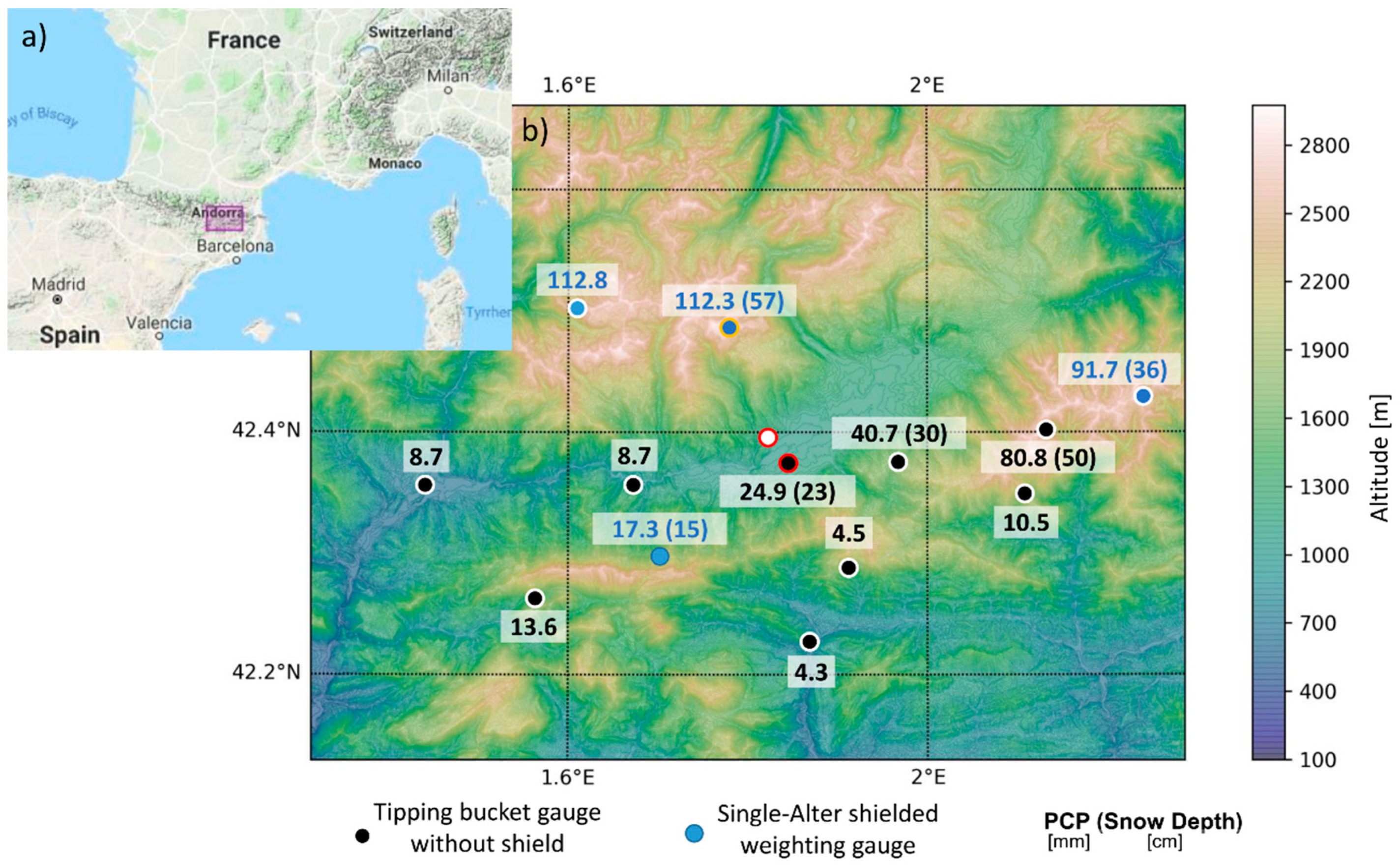
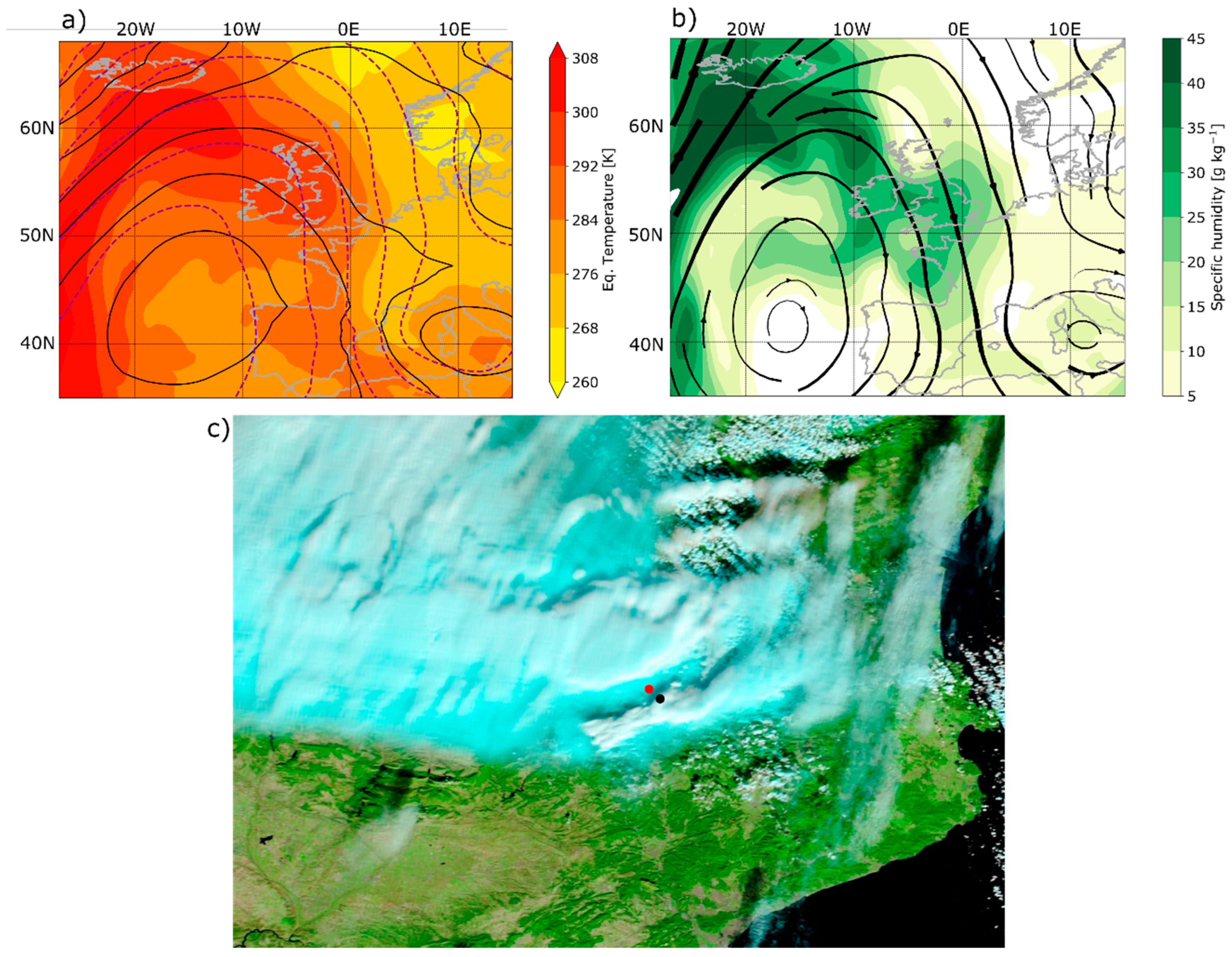

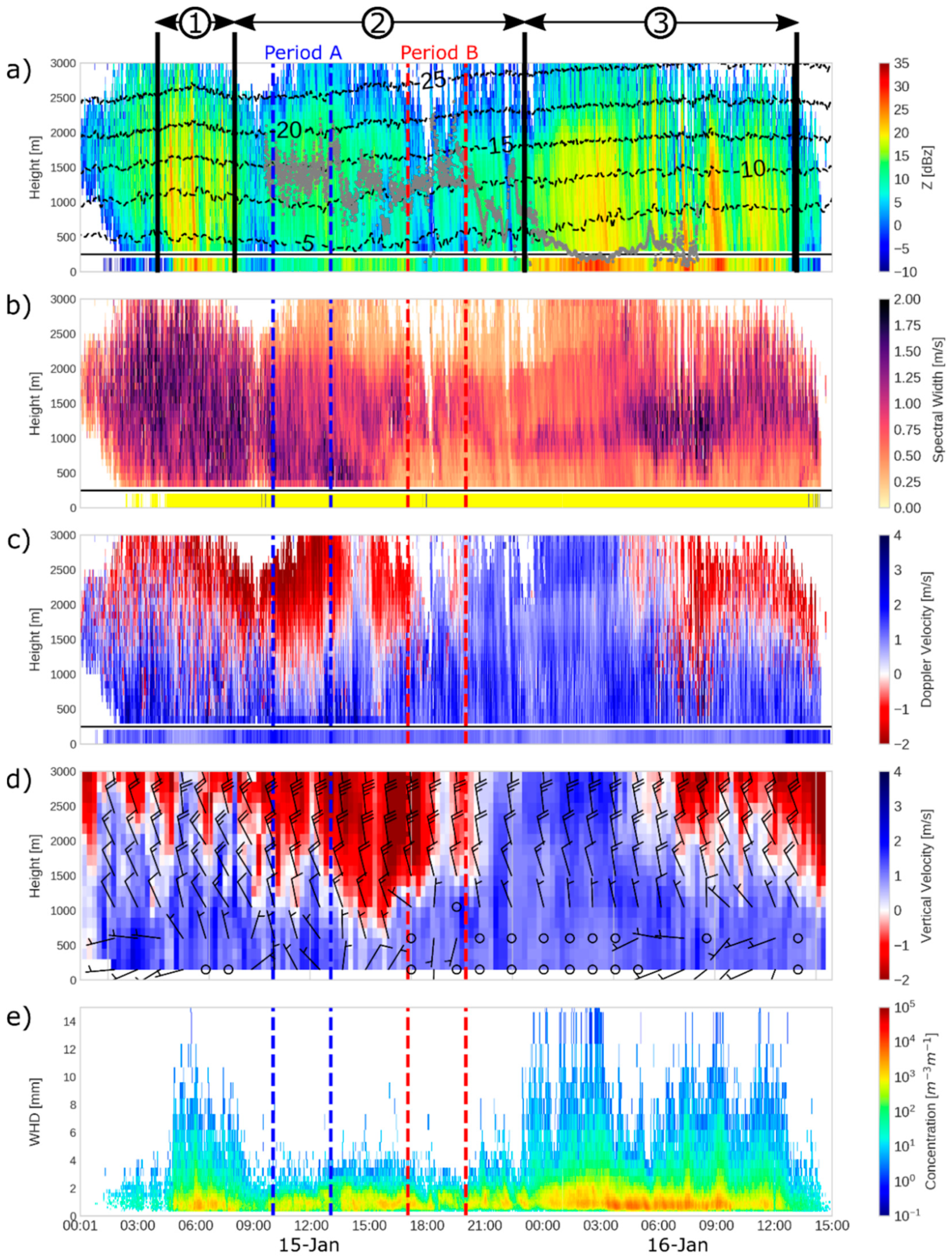
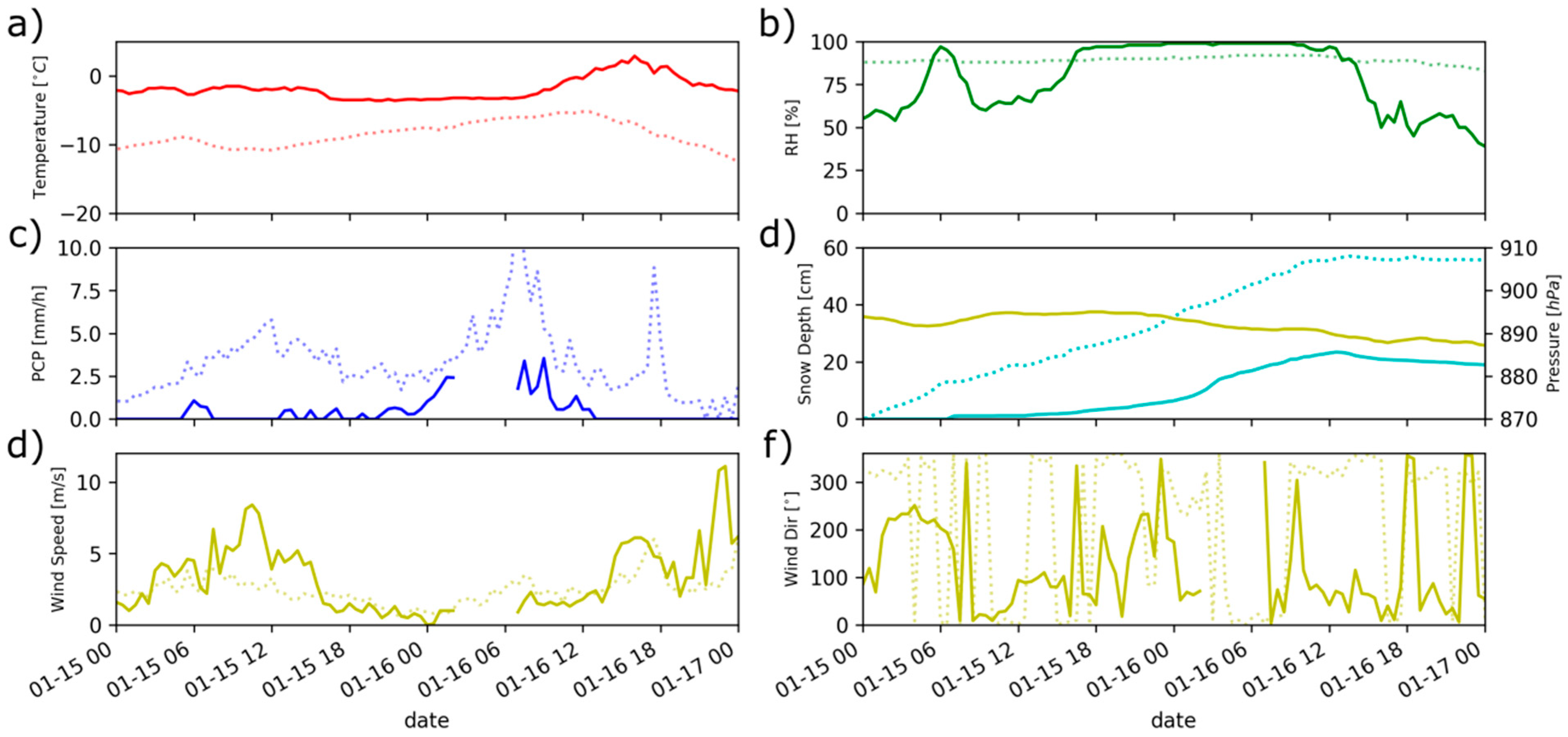
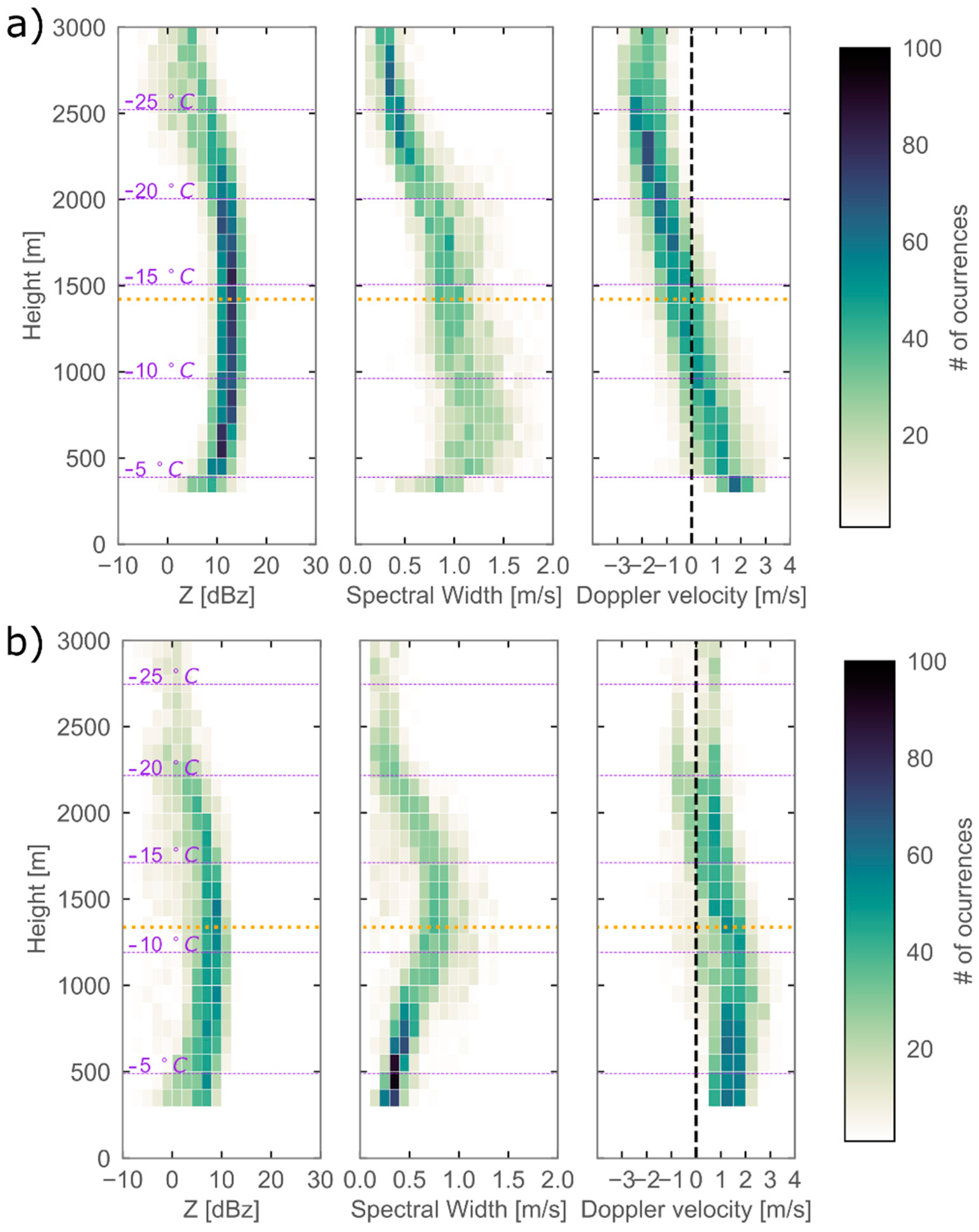
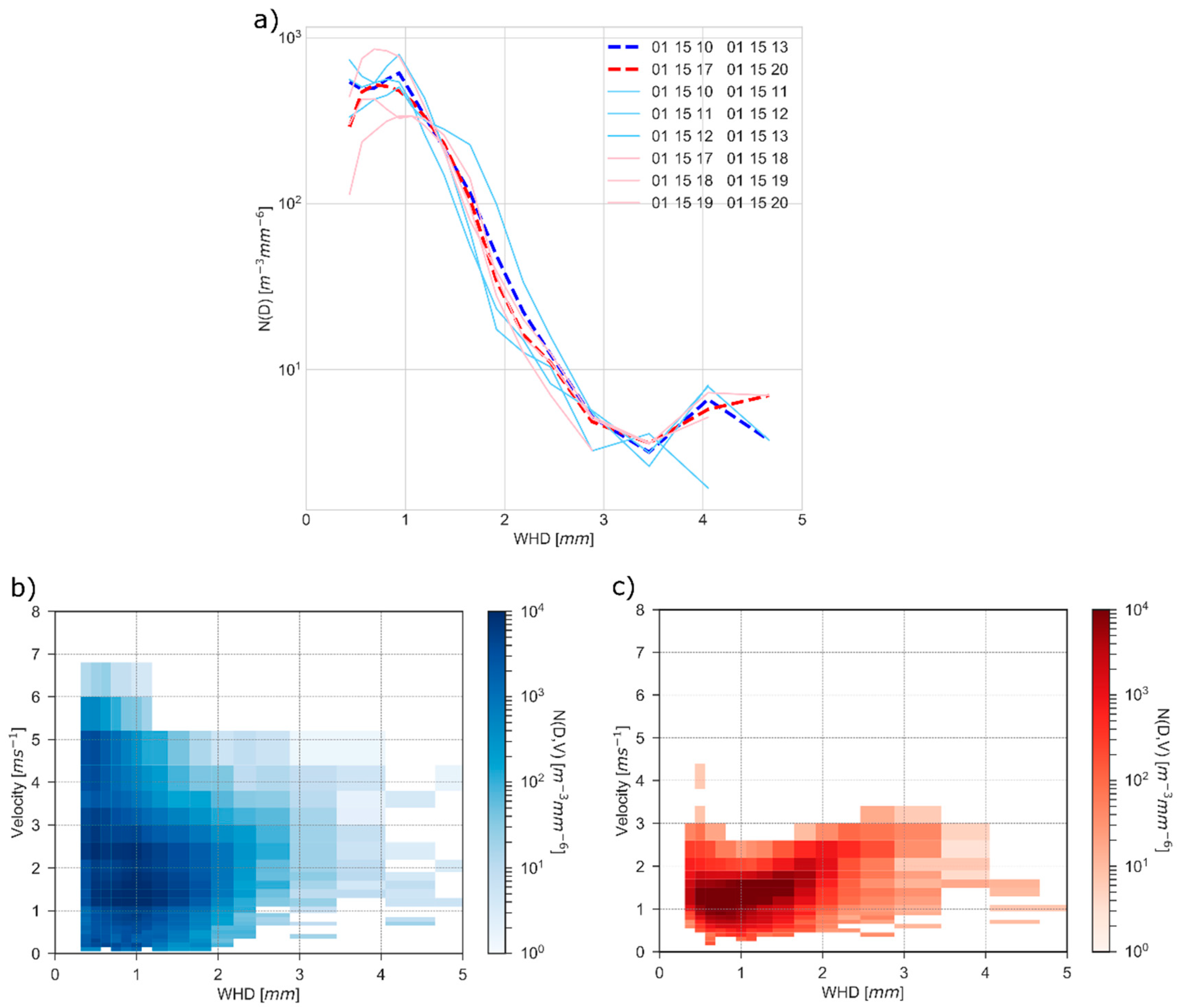
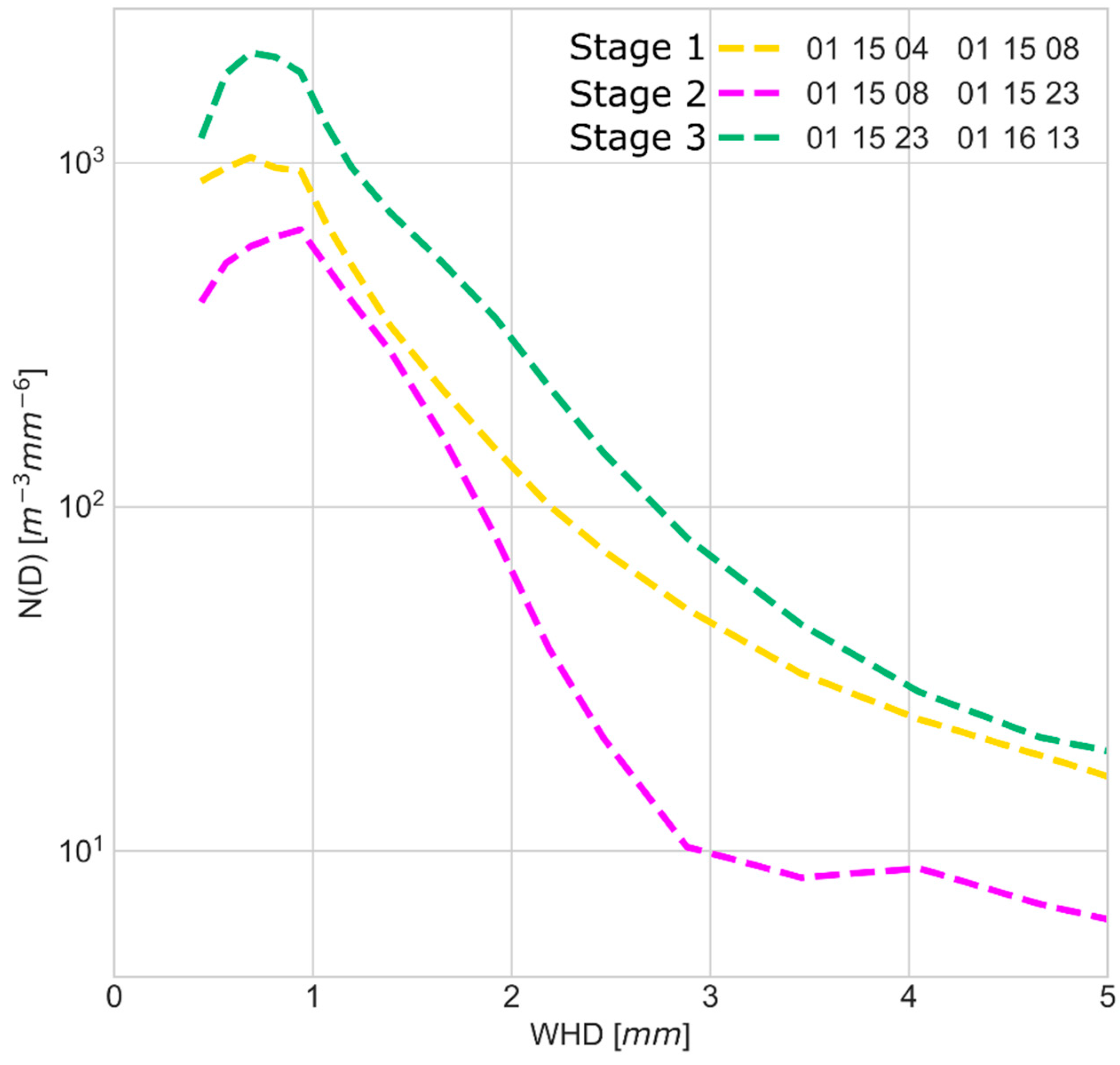
© 2019 by the authors. Licensee MDPI, Basel, Switzerland. This article is an open access article distributed under the terms and conditions of the Creative Commons Attribution (CC BY) license (http://creativecommons.org/licenses/by/4.0/).
Share and Cite
Gonzalez, S.; Bech, J.; Udina, M.; Codina, B.; Paci, A.; Trapero, L. Decoupling between Precipitation Processes and Mountain Wave Induced Circulations Observed with a Vertically Pointing K-Band Doppler Radar. Remote Sens. 2019, 11, 1034. https://doi.org/10.3390/rs11091034
Gonzalez S, Bech J, Udina M, Codina B, Paci A, Trapero L. Decoupling between Precipitation Processes and Mountain Wave Induced Circulations Observed with a Vertically Pointing K-Band Doppler Radar. Remote Sensing. 2019; 11(9):1034. https://doi.org/10.3390/rs11091034
Chicago/Turabian StyleGonzalez, Sergi, Joan Bech, Mireia Udina, Bernat Codina, Alexandre Paci, and Laura Trapero. 2019. "Decoupling between Precipitation Processes and Mountain Wave Induced Circulations Observed with a Vertically Pointing K-Band Doppler Radar" Remote Sensing 11, no. 9: 1034. https://doi.org/10.3390/rs11091034
APA StyleGonzalez, S., Bech, J., Udina, M., Codina, B., Paci, A., & Trapero, L. (2019). Decoupling between Precipitation Processes and Mountain Wave Induced Circulations Observed with a Vertically Pointing K-Band Doppler Radar. Remote Sensing, 11(9), 1034. https://doi.org/10.3390/rs11091034





